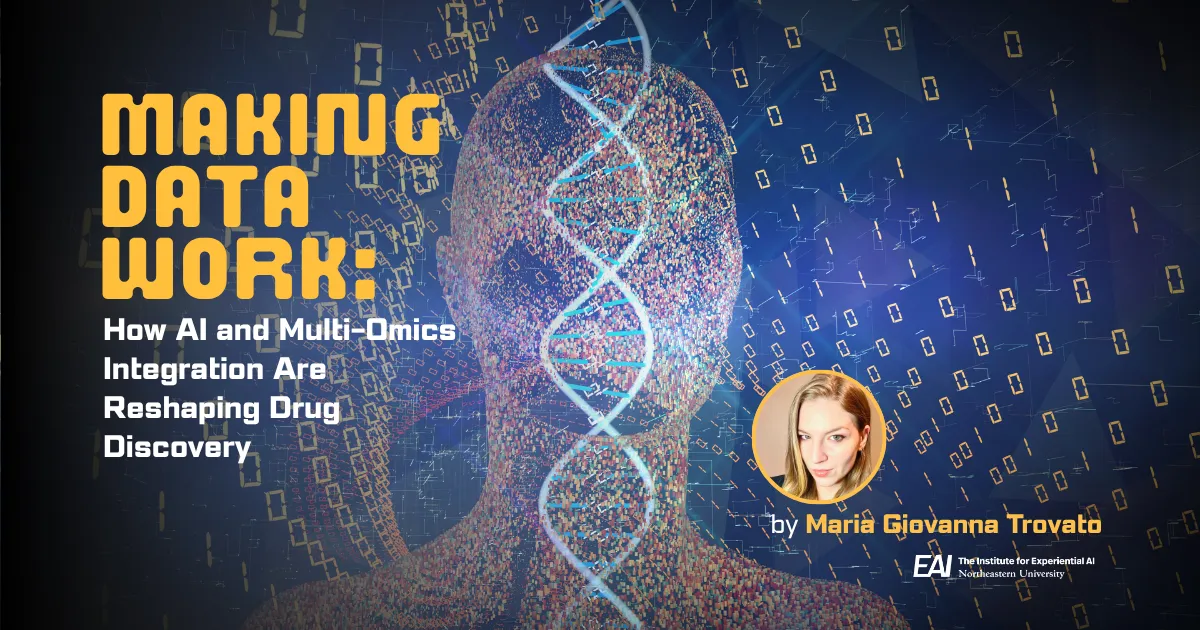National Science Foundation Meeting Underscores Potential of AI to Turn Data into Lifesaving Treatments

By: Zach Winn
New tools are allowing scientists to gather an unprecedented amount of data around genes, their expression, and the biological environment they interact with. But turning that data into treatments for disease will require new computational tools to make sense of all that information. Researchers believe artificial intelligence has a central role to play in that quest.
That was the takeaway from a recent National Science Foundation (NSF) meeting for Sam Scarpino, director of AI + Life Sciences at the Institute for Experiential AI. The three-day NSF meeting brought together about 60 researchers from around the country to explore ways to leverage a principle of evolution known as convergence, in which similar features —think wings or tails — independently evolve across different species and time periods.
The work served as a starting point for researchers to discuss some of the biggest challenges and opportunities in the life sciences more broadly, and AI played a prominent role in those discussions.
“It’s important for Northeastern University and the Institute for Experiential AI that we had a seat at the table here,” Scarpino says. “This wasn’t an AI conference talking about biology, this was a biology conference talking about computational methods and AI.”
The meeting was encouraging for Scarpino, whose team is already using AI to bring together disparate data from genomics, transcriptomics, proteomics, and more as part of a growing field known as multi-omics.
“Everybody was talking about AI,” Scarpino says of the meeting. “Sometimes that’s not a great thing because it starts to feel like a buzzword, but to me what’s motivating is that it’s very clear the research community is excited about leveraging our AI work to do data integration and hypothesis testing. One of the big problem spaces our Institute defined in the life sciences is multi-omic data integration, and that’s the thing that came out of this workshop as the big thing that we need to unlock all of these opportunities.”
Indeed, the Institute is already working with researchers from large healthcare organizations on multi-omics, and Scarpino’s own research has shown its potential to predict people’s response to the dengue virus.
“A huge amount of the resources we’ve brought into our Institute on the life sciences side are squarely focused on this multi-omic data integration,” Scarpino says. “We’re exploring many different application areas, like cancer and drug discovery. But it’s all fundamentally the same kind of problem.”
Multi-omics represents a new frontier in the life sciences industry, and processing huge amounts of data to better understand biological processes is a well-established strength of AI models.
“It’s only been relatively recently that we’ve had the right kind of data to study this [multi-omics] problem,” Scarpino says. “We now have these data in spades, but what we don’t have are the right modeling or analytic tools to bring all of these data together to answer these key biological questions and unlock opportunities around bioengineering, pathogen detection, and drug discovery. An individual who has cancer is going to be experiencing genetic, transcriptomic, and metabolomic changes, and in order to properly diagnose and identify treatment options, you have to evaluate that individual across all those different modalities.”
Scarpino found the meeting helpful for honing in on the kinds of issues the Institute’s in-house research team should be focusing on.
“We know there’s a huge amount of enthusiasm around AI, but it was useful to identify specific problems and application areas where there’s opportunities to do work right now,” Scarpino says. “It wasn’t just people bouncing around saying ‘AI’ a lot; it was people with specific problems and questions that they think could be addressed with AI.”
The meeting ended with groups of attendees presenting whitepapers that summarized their ideas. But Scarpino believes NSF’s ultimate goal with the meeting was to organize research priorities for future projects.
“Key outcomes from this meeting will be large scale research coordination efforts and proposals, and Northeastern and EAI are going to have a seat at the table for those projects as a result of being at this foundational meeting,” Scarpino says.
Read more about Sam's vision for the Institute’s AI + Life Sciences practice.


%20-%20EAI%20Team%20.webp)
%20(30).webp)
